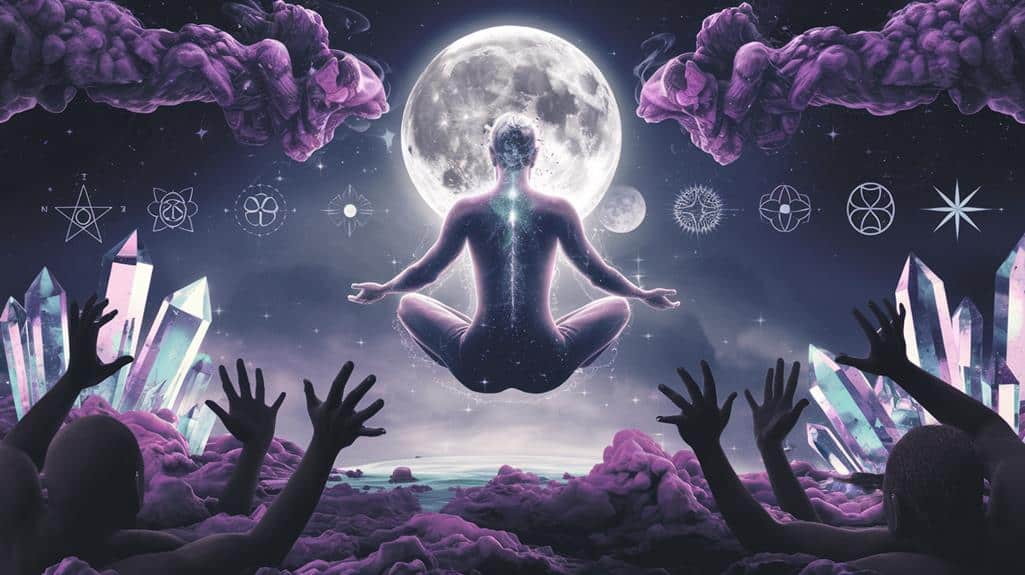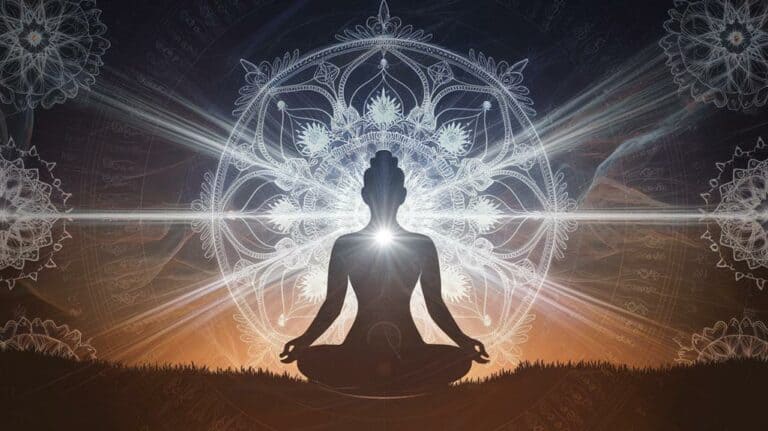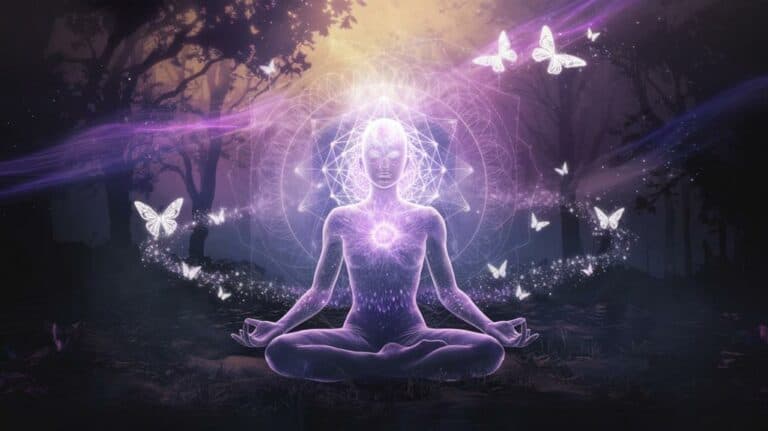The Concept of Spiritual Bypassing in Mystical Communities
You’ve likely encountered someone who responds to every hardship with “everything happens for a reason” or “just stay positive,” yet something about their approach feels inauthentic. This common phenomenon in spiritual communities, known as spiritual bypassing, occurs when people use spiritual beliefs to avoid confronting painful emotions and unresolved trauma. While the intention behind maintaining optimism isn’t inherently wrong, it’s vital to understand how this defense mechanism can actually hinder genuine healing and personal growth. Let’s explore why this seemingly harmless practice has become a significant concern in modern spiritual circles.
Defining Spiritual Bypassing
Two core concepts define spiritual bypassing: using spiritual beliefs to avoid dealing with emotional pain and psychological wounds, and employing spiritual practices as a shield against life’s uncomfortable realities.
When you’re caught in spiritual bypassing, you’ll often find yourself rushing to forgiveness before processing anger, claiming “it’s all love” while ignoring genuine grievances, or using meditation to escape rather than face your shadows.
You’ll recognize this pattern when you notice yourself using phrases like “everything happens for a reason” to dismiss real trauma, or when you’re quick to label negative emotions as “low vibration” rather than acknowledging their essential role in your healing journey.
The essence of spiritual bypassing lies in its subtle seduction – it masquerades as wisdom while actually preventing you from engaging with the full spectrum of human experience.
In mystical communities, you might encounter this tendency when practitioners prioritize transcendent experiences over emotional integration, or when spiritual teachers dismiss psychological work as “less evolved” than purely spiritual pursuits.
It’s important to understand that authentic spirituality embraces both the light and shadow aspects of your being.
Signs of Toxic Positivity
Closely related to spiritual bypassing, toxic positivity emerges as one of the most pervasive issues in spiritual communities.
You’ll recognize it when you’re told to “just be positive” while processing genuine grief, or when you’re shamed for experiencing natural human emotions like anger or sadness. This forced optimism can leave you feeling invalidated and disconnected from your authentic experience.
You’ll notice toxic positivity’s presence when community members dismiss systemic injustices with platitudes like “everything happens for a reason” or “just focus on love and light.”
It’s evident in the way some spiritual practitioners bypass accountability by claiming “we’re all one” while avoiding necessary confrontations with harmful behavior.
Watch for those who weaponize concepts like “high vibrations” to shame others who are working through challenging emotions or trauma.
These patterns often manifest in subtle ways: the meditation teacher who won’t acknowledge depression as real, the healing circle that ostracizes members who express doubt, or the spiritual mentor who insists you’re “creating your own reality” when you face discrimination.
You’ll find it’s essential to distinguish between authentic spiritual optimism and this harmful form of emotional suppression.
The Shadow Self
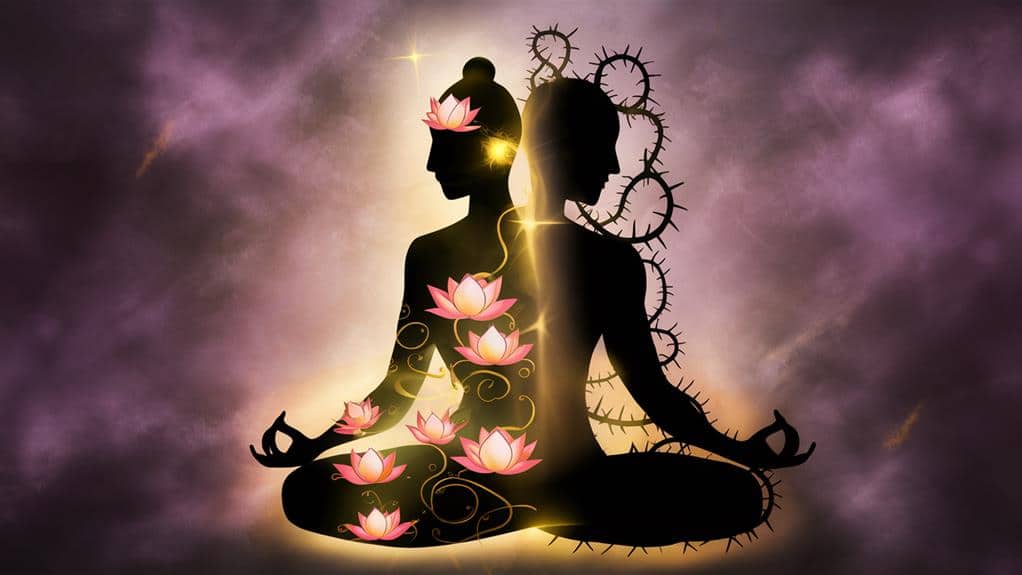
The shadow self represents those aspects of our psyche that spiritual communities often try to deny or suppress.
Within these darker corners of your being lie the emotions you’ve been taught to reject: anger, jealousy, grief, and shame.
When you deny these aspects, you’re not transcending them—you’re merely pushing them deeper into your unconscious, where they continue to shape your behavior in unseen ways.
You’ll find that embracing your shadow isn’t about indulging negative impulses, but rather about acknowledging their existence with courage and compassion.
As you explore these hidden dimensions, you’ll discover that what you’ve labeled as “negative” often carries profound wisdom and untapped potential.
Your anger might be protecting your boundaries; your grief might be teaching you about love’s depth; your shame might be guiding you toward authentic growth.
Common Defense Mechanisms
Within spiritual communities, defense mechanisms often masquerade as enlightened behaviors, creating an illusion of spiritual progress while actually blocking authentic growth.
You’ll recognize these patterns in yourself and others: toxic positivity that dismisses genuine pain, premature forgiveness that bypasses necessary healing, and intellectual discourse that substitutes for emotional processing.
When you’re confronted with uncomfortable truths, you might find yourself reaching for spiritual concepts as shields.
You’ll notice how easily meditation can become an escape rather than a tool for presence, or how quickly you’ll invoke “everything happens for a reason” to avoid facing life’s raw uncertainties.
These defense mechanisms show up as spiritual perfectionism, where you’re constantly working to embody an idealized version of enlightenment, or as spiritual narcissism, where you’re using spiritual achievements to mask deep-seated insecurities.
Pay attention to moments when you’re using spiritual practices to avoid rather than engage with life’s challenges.
Your growth lies not in transcending these patterns but in acknowledging them with compassion while gradually developing more authentic ways of relating to your spiritual journey.
Cultural Impact on Spiritual Communities
Cultural pressures have transformed modern spiritual communities into complex marketplaces where ancient wisdom often collides with contemporary consumerism.
You’ll find that traditional practices, once rooted in dedicated discipleship and patient cultivation, now compete with quick-fix solutions and packaged enlightenment experiences that promise instant transformation.
When you examine today’s spiritual landscape, you’ll notice how social media and digital platforms have reshaped the way you access and interpret sacred teachings.
You’re now traversing a world where ancient rituals blend with modern marketing, creating an environment where authenticity often struggles against commercialization.
The commodification of spirituality has led to a dilution of core teachings, as you’re increasingly encouraged to consume rather than embody spiritual principles.
You’ll observe how cultural appropriation and the westernization of Eastern practices have created hybrid forms of spirituality that sometimes miss the depth of their origins.
Yet within this complexity, you’re witnessing a unique moment where diverse traditions intersect, offering unprecedented opportunities for cross-cultural understanding – if you’re willing to move beyond superficial interpretations and engage with genuine spiritual inquiry.
Healing Trauma Through Integration
Moving beyond surface-level spirituality reveals a deeper challenge: addressing personal trauma through genuine spiritual practice.
You’ll discover that true healing emerges when you’re willing to integrate your wounded parts rather than transcend them through spiritual practices alone. Your path to wholeness requires embracing both the light and shadow aspects of your experience.
When you’ve experienced trauma, you might feel drawn to spiritual practices as a refuge, yet authentic healing demands that you face your pain with presence and compassion.
Through integration, you’re learning to hold space for your wounds while accessing the transformative power of spiritual awareness. This dual approach allows you to honor your experiences while moving toward greater wholeness.
You’ll find that integration isn’t about choosing between psychological healing and spiritual growth – it’s about weaving them together into a unified approach.
By acknowledging your trauma while remaining grounded in spiritual wisdom, you’re creating a foundation for lasting transformation.
This process invites you to embrace both your humanity and your divinity, recognizing that genuine spiritual evolution includes rather than bypasses your wounds.
Beyond Spiritual Materialism
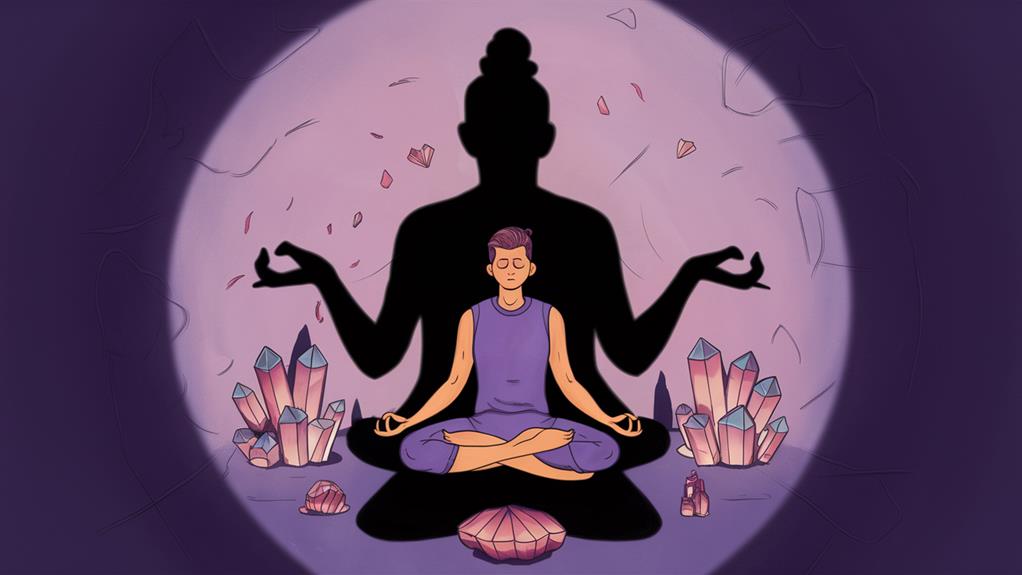
Today’s spiritual marketplace often reduces profound teachings to commodified quick fixes, creating what Chögyam Trungpa called “spiritual materialism.”
You’ll notice this tendency when practitioners collect workshops, retreats, and teachings like shopping sprees, mistaking spiritual experiences for genuine transformation.
To move beyond spiritual materialism, you’ll need to examine your motivations with unflinching honesty.
Ask yourself whether you’re seeking temporary comfort or lasting liberation, whether you’re using spiritual practices to enhance your ego rather than transcend it.
The path demands more than accumulating experiences or knowledge—it requires integration, embodiment, and the courage to face your shadows.
You’ll discover that authentic spiritual growth isn’t found in the next workshop or the latest technique, but in your consistent dedication to presence and truth.
When you strip away the trappings of contemporary spirituality, what remains is the timeless invitation to wake up from illusion.
Your journey isn’t about adding more layers of spiritual identity but about removing the veils that obscure your essential nature.
This understanding transforms spiritual practice from consumption to revelation.
Authentic Spiritual Growth
Genuine spiritual evolution unfolds through sustained inner work rather than spiritual consumption. You’ll discover that authentic growth demands facing your shadows, processing difficult emotions, and embracing the full spectrum of human experience rather than seeking perpetual bliss states or quick fixes.
When you’re willing to sit with discomfort and examine your patterns with unflinching honesty, you’re engaging in true spiritual development.
Your path to authenticity requires discernment between genuine transformation and spiritual materialism. You’ll need to question whether you’re using spiritual practices to avoid life’s challenges or to meet them with greater awareness and compassion.
The journey isn’t about accumulating experiences or collecting wisdom like trophies; it’s about integrating insights into your daily life and relationships.
As you navigate this territory, you’ll find that authentic growth often feels less spectacular than promised by spiritual marketing.
It’s in the quiet moments of self-reflection, in choosing presence over escape, and in meeting life’s complexities with an open heart that you’ll discover your truest evolution.
This process demands patience, commitment, and the courage to remain genuine in a world that often prefers spiritual shortcuts.
Balancing Light and Dark
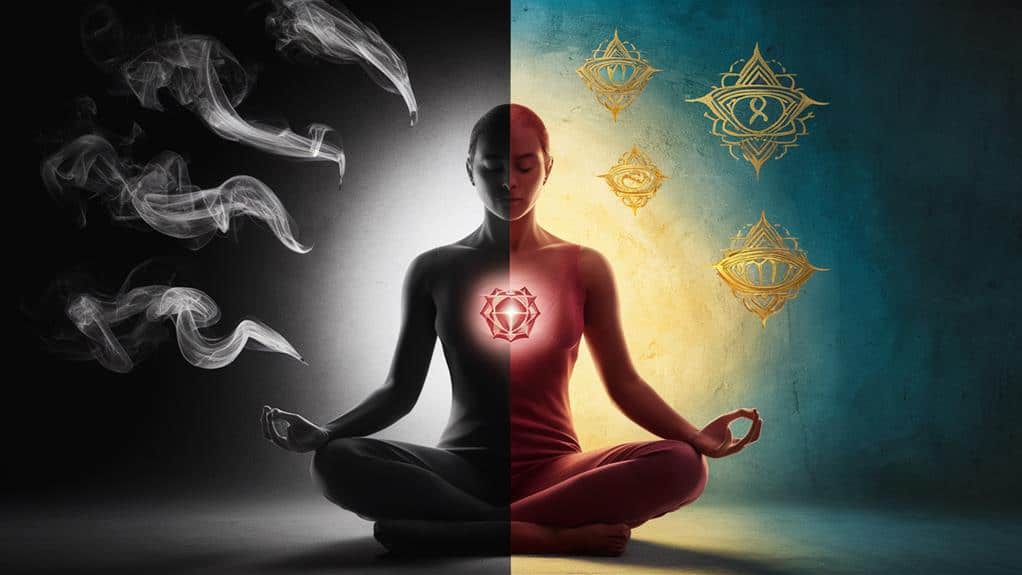
The spiritual journey requires embracing both light and shadow aspects of your being, rather than solely pursuing positivity.
When you acknowledge your darker elements – your fears, wounds, and unconscious patterns – you’ll discover they hold profound teachings that can catalyze your evolution.
These shadow aspects aren’t enemies to be vanquished but integral parts of your wholeness waiting to be integrated.
You can’t transcend what you haven’t first acknowledged and understood.
By diving into your depths with courage and compassion, you’ll find that your perceived imperfections often contain seeds of wisdom and strength.
The practice of spiritual bypassing occurs when you use spiritual concepts to avoid facing these uncomfortable truths, creating an artificial separation between what you consider “spiritual” and “unspiritual” aspects of yourself.
True spirituality isn’t about escaping into perpetual light but about discovering the sacred in all expressions of consciousness.
When you honor both the light and dark within, you’ll experience a more authentic awakening – one that encompasses the full spectrum of human experience rather than fragmenting yourself into acceptable and unacceptable parts.
Breaking the Cycle
Once you recognize patterns of spiritual bypassing in your life, breaking free requires conscious effort and radical honesty.
You’ll need to face the uncomfortable truths you’ve been avoiding and acknowledge the ways you’ve used spiritual practices as shields against genuine emotional work. This journey demands that you cultivate discernment between authentic spiritual experiences and escapist tendencies.
Begin by examining your spiritual beliefs and practices with fresh eyes, questioning whether they’re serving your growth or enabling avoidance.
You’ll find that true spiritual development doesn’t bypass life’s challenges but rather embraces them as catalysts for transformation.
When you notice yourself reaching for spiritual explanations to sidestep difficult emotions, pause and allow yourself to fully experience what’s arising.
Your path forward lies in integration rather than transcendence alone.
You’re called to weave together your spiritual awareness with earthly experiences, creating a more authentic and grounded approach to spirituality.



